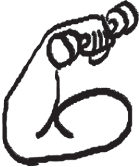How to Use This Book
As You Read
The first time you read this book, we recommend you move through it from beginning to end, since lessons in each chapter carry through to all chapters that follow. Don't read passively like you're sitting in on a lecture. After all, this is a lab. Actively reflect on your own behaviors along the way. Ask yourself:
- “Do I do this?”
- “What might I try doing differently?”
- “When can I try it?”
When an insight strikes, pause to jot it down in the margins. For even faster learning, summarize the key points you learned, and share them with your manager, your team, your cat, or anyone willing to listen. Research shows that we learn faster by teaching, a handy phenomenon known as the “protégé effect” (Chase et al. 2009).

Mia the Manager
Throughout the book, you'll get to see leadership in action, much like we got to do through our research. In each chapter, you'll listen in on conversations with a manager named Mia (a composite of our research participants) as she navigates the ups and downs of her role. Mia is a first-time manager with a common story: she's inexperienced, overwhelmed, and determined to do a good job. There's just one thing about Mia that is decidedly uncommon. She has a magic Do-Over Button. That's right. While the great managers we studied “replayed” their management moments in their minds, Mia has the unique advantage of going back in time to try again.
“Wait, time travel?” you might be saying. “Why introduce one of the most notoriously complex plot devices into a book on leadership skills?” Well, for starters, because this might be the only chance we get to publish sci-fi. But more importantly, because people's brains learn best through observation. By following Mia's story and hearing the contents of her team's “black box,” you'll get to spot common leadership mistakes in real time, see each BU and skill in action, and strengthen your own management muscles. Along the way, we encourage you to travel back to instances in your own past where you succeeded or stumbled as a manager, and bring experiment ideas back to the future for your personal leader lab.

Practice Stations
Distributed throughout each chapter, you'll also see “Practice Stations,” as you would in a physical laboratory. Spend some time at these stations to rapidly transform your insights into habits. These stations are an opportunity to test out what you've learned and collect brain-friendly tips to help the learning stick in your memory.
![]() Bonus: For live practice and real-time feedback, visit leaderlab.lifelabslearning.com.
Bonus: For live practice and real-time feedback, visit leaderlab.lifelabslearning.com.

Your Lab Reports
At the end of each chapter, you'll have a personal Lab Report to complete that will prompt you to do the following:
- Extract your takeaways from the chapter so you can easily return to them later.
- Assess your current competence level to increase your self-awareness.
- Select a small experiment from a bank of ideas to try in your own leader lab.
- Extract your learnings once you have tried out the experiment to accelerate your learning.

Bonus Inclusion Stations
Because great leadership is synonymous with inclusive leadership, you'll also have access to bonus “Inclusion Stations” at leaderlab.lifelabslearning.com. Visit these Inclusion Stations for extra support in applying the lessons in this book to every member of your team, mitigating the impact of bias, and giving each person access to great leadership. You'll discover research and pro tips for cross-cultural collaboration, leading remote and distributed teams, as well as overall inclusion guidance. Why apply an inclusive lens to how you lead? Because teams are increasingly diverse, which means managers have to take deliberate action to leverage this diversity and overcome individual and systemic bias. Companies that harness the strength of their differences are more resilient, engaged, and see an average of 45% more revenue growth than their peers (Hewlett, Marshall, and Sherbin 2013).
Finally, give yourself an occasional fist bump or high five for your effort along the way. The world needs more great managers. Thank you for putting in the work to become an even better manager.
